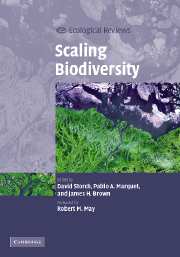Book contents
- Frontmatter
- Contents
- List of contributors
- Foreword by Robert M. May (Lord May of Oxford)
- Preface
- 1 Introduction: scaling biodiversity – what is the problem?
- PART I Spatial scaling of species richness and distribution
- PART II Alternative measures of biodiversity: taxonomy, phylogeny, and turnover
- 7 Biodiversity scaling relationships: are microorganisms fundamentally different?
- 8 The importance of phylogenetic structure in biodiversity studies
- 9 On the quantification of local variation in biodiversity scaling using wavelets
- 10 The scaling of spatial turnover: pruning the thicket
- PART III Scaling of biological diversity with energy and the latitudinal biodiversity gradient
- PART IV Processes, perspectives, and syntheses
- Index
- Plate section
- References
8 - The importance of phylogenetic structure in biodiversity studies
Published online by Cambridge University Press: 05 August 2012
- Frontmatter
- Contents
- List of contributors
- Foreword by Robert M. May (Lord May of Oxford)
- Preface
- 1 Introduction: scaling biodiversity – what is the problem?
- PART I Spatial scaling of species richness and distribution
- PART II Alternative measures of biodiversity: taxonomy, phylogeny, and turnover
- 7 Biodiversity scaling relationships: are microorganisms fundamentally different?
- 8 The importance of phylogenetic structure in biodiversity studies
- 9 On the quantification of local variation in biodiversity scaling using wavelets
- 10 The scaling of spatial turnover: pruning the thicket
- PART III Scaling of biological diversity with energy and the latitudinal biodiversity gradient
- PART IV Processes, perspectives, and syntheses
- Index
- Plate section
- References
Summary
Introduction
A central goal of biodiversity research is to understand processes of species coexistence at different spatial and temporal scales. Much empirical research has revolved around documenting patterns of species abundance and distribution with sound sampling techniques and statistics (May, 1975; Magurran, 1988; Krebs, 1998). Such data are of tremendous importance not only for documenting current biological diversity patterns, but also for testing fundamental ecological theories (Ricklefs & Schluter, 1993; Brown, 1995; Hubbell, 2001). A common feature of these approaches is the emphasis placed on species as the appropriate currency for quantifying biological diversity. However, documenting species diversity often represents a considerable practical challenge. First, no one exactly knows the total number of extant species on Earth (Erwin, 1982; May, 1994; Novotný et al., 2002; Alroy, 2002). Second, in any given sample, a sizeable fraction of the individuals may represent previously undescribed species, as is especially the case for lesser known groups, like plants in tropical forests, insects or protists. Third, species recognition usually relies upon a set of morphological cues which are not always observable. Thus, many individuals within a sample cannot be reliably assigned to previously described species. This is obvious in microbial communities, where different operational taxonomic units (OTUs) can only be distinguished by DNA screening or other molecular methods (e.g. see Suau et al., 1999 for a study of the microbial diversity of the human gut, and Green & Bohannan, this volume). This issue is also serious in macroscopic organisms.
- Type
- Chapter
- Information
- Scaling Biodiversity , pp. 150 - 167Publisher: Cambridge University PressPrint publication year: 2007
References
- 22
- Cited by

